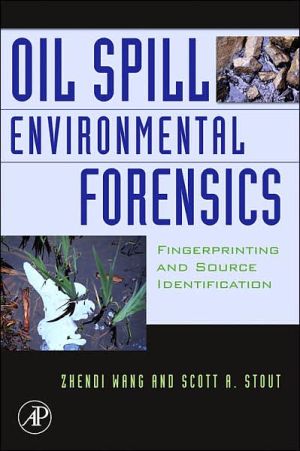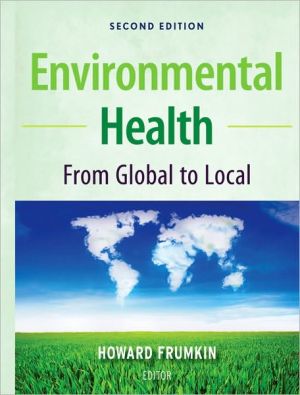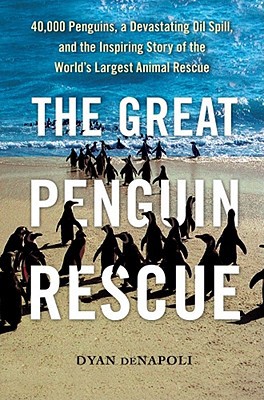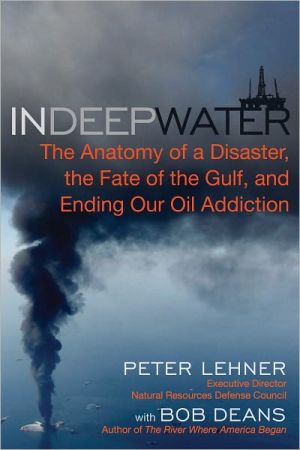Oil Spill Environmental Forensics: Fingerprinting and Source Identification
Oil Spill Environmental Forensics provides a complete view of the various forensic techniques used to identify the source of an oil spill into the environment. The forensic procedures described within represent various methods from scientists throughout the world. The authors explore which analytical and interpretative techniques are best suited for a particular oil spill project. \ This handy reference also explores the use of these techniques in actual environmental oil spills. Famous...
Search in google:
Oil Spill Environmental Forensics provides a complete view of the various forensic techniques used to identify the source of an oil spill into the environment. The forensic procedures described within represent various methods from scientists throughout the world. The authors explore which analytical and interpretative techniques are best suited for a particular oil spill project. This handy reference also explores the use of these techniques in actual environmental oil spills. Famous incidents discussed include the Exxon Valdez incident in 1989 and the Guanabara Bay, Brazil 2000. The authors chronicle both the successes and failures of the techniques used for each of these events. Dr. Zhendi Wang is a senior research scientist and Head of Oil Spill Research of Environment Canada, working in the oil and toxic chemical spill research field. He has authored over 270 academic publications and won a number of national and international scientific honors and awards. Dr. Wang is a member of American Chemical Society (ACS), the Canadian Society for Chemistry (CSC), and the International Society of Environmental Forensics (ISEF).*International experts show readers the forensic techniques used in oil spill investigations*Provides the theoretical basis and practical applications for investigative techniques*Contains numerous case studies demonstrating proven techniques
Preface xlviiContributors xlixChemical Fingerprinting of Spilled or Discharged Petroleum - Methods and Factors Affecting Petroleum Fingerprints in the Environment 1Introduction 1Methods for Chemical Fingerprinting Petroleum 3Historical Perspective 3Tier 1 - Chemical Fingerprinting via GC/FID 6Tier 2 - Chemical Fingerprinting via GC/MS 7Polycyclic Aromatic Hydrocarbons 8Petroleum Biomarkers 9Quality Assurance and Quality Control 10Quality Control 10Quality Assurance 10Factors Controlling the Chemical Fingerprints of Spilled or Discharged Petroleum 11Primary Control - Crude Oil Genesis 13Secondary Controls - Petroleum Refining 18Gasoline 21Distillate Fuels 22Residual Fuels 27Lubricating Oils 28Oily Waste/Bilge Water Discharges 28Tertiary Controls - Weathering 29Evaporation 30Dissolution 32Biodegradation 32Photooxidation 34Mousse Formation 34De-Waxing and Wax Enrichment 34Tertiary Controls-Mixing with "Background" 36What Is "Background"? 36Recognizing and Establishing Background 37Naturally Occurring Background Hydrocarbons 37Vascular Plant and Algal Debris 38Particulate Coal and Wood Charcoal 39Natural Oil Seeps 41Anthropogenic Background Hydrocarbons 41Urban and River Runoff 42Summary 43References 45Spill Site Investigation in Environmental Forensic Investigation 55Introduction 55Environmental Site Characterization and Reconnaissance Survey 55Site Entry and Safety Issues during the Emergency Response Phase 57Management of Safety 57Risk Assessment and Characterization 58Chemical Toxicity of the Spilled Oil 59Working Environment Safety 60Personal Protective Equipment (PPE) 60Determination of Geographic Boundary and Definition of Different Zones within the Affected Area: 1. Terrestrial Oil Spills 61Determination of Geographic Boundary and Definition of Different Zones within the Affected Area: 2. Marine/Coastal Waterborne Oil Spills 62Collection of Physical, Ecological, and Environmental Data 63Sampling Plan and Design: 1. Spills with Known Source 64Water Column Sampling 64Oil Source Sampling 65Sampling on Land 65Sampling Plan Design 65Sampling Plan and Design: 2. "Mystery" Spills 66Data Management 67Conclusions 71References 71Petroleum Biomarker Fingerprinting for Oil Spill Characterization and Source Identification 73Introduction 73Analytical Methodologies for Petroleum Biomarker Fingerprinting 74Petroleum Biomarker Families 74Acyclic Terpenoids or Isoprenoids 75Cyclic Terpenoids 75Labeling and Nomenclature of Biomarkers 77Stereoisomers 79Asymmetric (or Chiral) Carbons and [Alpha] and [Beta] Stereoisomers 80R and S Stereoisomers of Cyclic Biomarkers 81Analysis Methods for Biomarker Fingerprinting 81Capillary Gas Chromatography - Mass Spectrometry (GC-MS) 83Benchtop Quadrupole GC-MS 84Scan Mode 84Selected Ion Monitoring (SIM) Mode 84Example Benchtop GC-MS Conditions (EC Oil Spill Research Laboratory) 85Example Benchtop GC-MS Conditions (Petrobras Geochemistry Laboratory) 85Triple Quadrupole GC-MS-MS 85Mass Spectra and Identification of Biomarkers 86Fingerprinting Petroleum Biomarkers 90Biomarkers in Crude Oils 90Biomarkers in Petroleum Products 99Biomarkers in Lubricating Oils 101Biomarkers in Oil Fractions with Different Carbon Number Range 104Aromatic Steranes in Oils and Petroleum Products 104Sesquiterpanes in Oils and Petroleum Products 109Diamondoid Compounds in Oils and Lighter Petroleum Products 114Application of Biomarker Fingerprintings to Oil Spill Studies 117Source-Specific Biomarkers 1213.3.10 Using Diagnostic Ratios and Cross-Plots of Biomarkers for Source Identification of Oil Spills 125Diagnostic Ratios of Biomarkers 126Cross-Plots of Biomarkers 128Effects of Weathering on Biomarker Fingerprinting 130Processes Affecting the Fate and Behavior of Spilled Oil 130Weathering Effects on Biomarkers Fingerprinting 132Biodegradation of Biomarkers in Spilled Oil 133Determination of Weathered Percentages Using Biomarkers 134Case Study: Source Identification of a Harbor Spill by Forensic Fingerprinting of Biomarkers 134Product Type-Screening 134Characterization of Bicyclic Sesquiterpanes 135Confirmation of Source Identification by Quantitative Evaluation of Alkylated PAHs and Pentacyclic Terpanes and Steranes 135Conclusions 138References 140Characterization of Polycyclic Aromatic Sulfur Heterocycles for Source Identification 147Introduction 147Sulfur Compounds in Crude Oil and Petroleum Products 148Influence of Refinery Processes on PASH Patterns 150Stability of Polycyclic Aromatic Sulfur Heterocycles in the Environment 152Petroleum PASH Analysis Techniques 155Selective Detection in Gas Chromatography 156Flame Photometric Detection (FPD) 156Atomic Emission Detection (AED) 157Sulfur Chemiluminescence Detection (SCD) 157Mass-Selective Detection (MSD) 157Class Separation of PAH and PASH 157Comprehensive Two-Dimensional Gas Chromatography 158Quantification of PASH 158Petroleum PASH Markers in Environmental Forensic Investigations 159PASHs as Source Markers 160PASHs as Weathering Markers 162Conclusions 164References 164Oil Spill Identification by Comprehensive Two-Dimensional Gas Chromatography (GC x GC) 169Introduction 169The Need for High-Resolution Separations 169Multidimensional Methods 170Comprehensive Two-Dimensional Gas Chromatography (GC x GC) 171Modulation Techniques 172Detectors 172Data Processing 173GC x GC Chromatogram 174Peak Identity and Chromatogram Structure 175GC x GC Petroleum Applications 180Applications of GC x GC to Fingerprint Oil Spills 181Mobile Bay Marine Diesel Fuel Spill 181West Falmouth No. 2 Fuel Oil Spill 184Winsor Cove No. 2 Fuel Oil Spill 187Buzzards Bay No. 6 (Bunker C) Spill 191Oil Seeps, Santa Barbara, CA, USA 196Conclusion 201Acknowledgments 202References 202Application of Stable Isotope Ratios in Spilled Oil Identification 207Introduction 207Isotope Ratios and Their Measurement 207Bulk Isotope Ratios 210Compound-Specific Isotope Analysis (CSIA) 214Experimental Considerations 220Weathering 220Other Isotopes 224Conclusions 224References 225Emerging CEN Methodology for Oil Spill Identification 229Introduction 230Scope of the CEN Methodology 231Strategy for Identifying Oil Spills 231Tiered Levels of Analysis and Data Treatment 233Decision Chart for Identifying Oil Spills 233Visual Characterization and Preparation/Cleanup of Oil Samples 233Level 1 - GC/FID Screening 235Evaluation of Weathering 236Level 2 - GC/MS Fingerprinting 237Diagnostic Ratios from GC/MS Fingerprinting 237Diagnostic Ratios Derived from Alkylated Polycyclic Aromatic Compounds 238Diagnostic Ratios Derived from Petroleum Biomarkers 239Optional Diagnostic Ratios Derived from Sesquiterpanes 240Level 3 - Treatment of Results 245Comparison of Oil Samples Using Diagnostic Ratios 245Criteria for Selecting, Eliminating, and Evaluating Diagnostic Ratios 245Repeatability Limit and Critical Difference 246Elimination of Diagnostic Ratios Using Signal-to-Noise (S/N) Test 246Elimination of Diagnostic Ratios Using Duplicate Analyses 248Optional Comparison of Diagnostic Ratios Using Multivariate Statistics 249Final Evaluation and Conclusions 250The CEN Methodology in Practice: A Case Study 251The Spill Case 251GC/FID Screening 251GC/MS Fingerprinting 251Evaluation and Comparison of Diagnostic Ratios 251Summary 254Acknowledgment 255References 255Advantages of Quantitative Chemical Fingerprinting in Oil Spill Source Identification 257Introduction 257Qualitative Fingerprinting Methods 258Shortcomings of Qualitative Fingerprinting 260Weathered Oils 260Genetically Similar Oils 260Qualitatively Similar Oils 261Mixing 261Quantitative Fingerprinting Methods 263Semiquantitative versus Fully Quantitative Methods 263Data Generation for Fully Quantitative Fingerprinting 265Sample Collection 265Sample Preparation 266GC/FID Analysis 266GC/MS Analysis 268Data Quality 269Selection of Diagnostic Indices 269Source Identification Protocols for Quantitative Fingerprinting Data 272Unraveling Mixed Source Oils Using Quantitative Fingerprinting Data 276Two-Component Mixing Models 276Case Study 1 277Case Study 2 279Mixing Model Case Study 2 284Summary 289References 290A Multivariate Approach to Oil Hydrocarbon Fingerprinting and Spill Source Identification 293Introduction 293Multivariate Methods and Oil Fingerprinting 294Integrated Multivariate Oil Fingerprinting (IMOF) 296Sample Preparation and Chemical Analysis 297Sample Preparation 297Analytical Methods 298Fluorescence Spectroscopy 298GC-MS 299Quality Assurance and Quality Control (QA/QC) 301Data Preprocessing 302Partial GC-MS/SIM Chromatograms 303Baseline Removal 303Retention Time Alignment 304Normalization 306Diagnostic Ratios 306Preprocessing of Fluorescence Spectra 307Multivariate Statistical Data Analysis 308Multilinear Models 310Two-Way Case 310Higher-Order Arrays 311Variable Selection and Scaling 312Data Evaluation 314Visual Inspection of Score and Loading Plots 315Numerical Comparisons and Statistical Tests 317Conclusions and Perspectives 319Acknowledgments 321References 322Chemical Heterogeneity of Modern Marine Residual Fuel Oils 327Introduction 327Historical Perspective 328Production of Heavy Fuel Oils 328Marine Fuel Nomenclature and Classification 329Forensic Chemistry Considerations 330General Chemical Fingerprinting 330Samples and Analytical Methods 332General Features of Modern Residual Marine Fuel Oils 332Molecular Variability among Modern Residual Fuel Oils 336Petroleum Biomarkers 336Polycyclic Aromatic Hydrocarbons 338Distinguishing Heavy Fuel Oils from Crude Oil 343Conclusion 346References 346Biodegradation of Oil Hydrocarbons and Its Implications for Source Identification 349Introduction 349Biochemistry of Petroleum Biodegradation 349Aerobic Biodegradation of Hydrocarbons 351Anaerobic Biodegradation of Hydrocarbons 355Subsurface Biodegradation of Petroleum 357The Biodegradation of Hopanes and the Formation of 25-Norhopanes 360Factors Limiting Biodegradation 362Microbial Ecology of Petroleum Biodegradation 365The Succession of Microbial Communities 365Deep Subsurface Ecology 367Aerobic Respiration 367Anaerobic Respiration 368Conclusions; Implications of Biodegradation on Identification 369References 370Identification of Hydrocarbons in Biological Samples for Source Determination 381Introduction 381Determination of the Primary Route of Hydrocarbon Accumulation by Biota 382Catabolic Degradation of Hydrocarbons Accumulated by Biota 387Catabolic Degradation of PAH 387Effects of Catabolism on PAH Accumulation, Persistence, and Depuration 390Modes of Toxic Action of Accumulated Hydrocarbons 393Case Study: The Exxon Valdez Oil Spill 396Summary 398References 398Trajectory Modeling of Marine Oil Spills 405Introduction 405Forecasting and Hindcasting Oil Spill Movement 406Oil Spill Transport 407Wind 409Currents 411Turbulent Diffusion 413Evolution of an Oil Spill 413Spreading 413Oil Weathering 414Conclusions and Challenges 416Acknowledgments 416References 416Oil Spill Remote Sensing: A Forensic Approach 419Introduction 419Visible Indications of Oil 420Optical Sensors 420Visible 420Infrared 422Ultraviolet 423Night Vision Cameras 423Laser Fluorosensors 423Microwave Sensors 426Radiometers 426Radar 426Microwave Scatterometers 428Determination of Slick Thickness 428Visual Thickness Indications 428Theoretical Approaches 429Literature Review of Visual Indications of Oil Slick Thickness 429Oil Slick-Thickness Relationships in Remote Sensors 431Specific Oil-Thickness Sensors 432Acoustic Systems 435Satellite Remote Sensing 435Detection of Oil under Ice 436Real-Time Displays and Printers 438Future Trends 438References 439Advances in Forensic Techniques for Petroleum Hydrocarbons: The Exxon Valdez Experience 449Introduction 449Identification of Hydrocarbon Sources in PWS 450Multiple Sources of Hydrocarbons 450Petrogenic Hydrocarbons 451Biogenic Hydrocarbons 453Pyrogenic Hydrocarbons 453Composition of Exxon Valdez Crude and Its Weathering Products 453Bulk Composition and Trace Chemistry 453Weathering Trends 457Data Sources 457Major Fraction Trends 457PAH Trends 457Mass Loss during Weathering 458Resolution of Inputs to the Natural Background 458Hydrocarbon Source Allocations 462Source Allocation Models 462Qualitative Allocation Models 464Quantitative Models 464PAH Ratios 464Statistical Models 465Statistical Models 466Multivariate Methods - Constrained Least Squares 466Multivariate Analysis - Partial Least Squares 468Total Organic Carbon (TOC) Constraints on Source Allocations 468Allocation of Anthropogenic Sources of PAH 469Identification of Hydrocarbons in Biological Samples 470Applications of Forensic Methods to Assessments of Oil Bioavailability 477PAH Uptake in Biota 477Passive Sampling of PAH in Water 481Biological Markers 481Summary 482Acknowledgments 483References 483Case Study: Oil Spills in the Strait of Malacca, Malaysia 489Strait of Malacca, Malaysia: Introduction 489Hydro-Oceanographic Condition of the Strait 489Ship Traffic in the Strait of Malacca: Historical and Present 491Chronic and Acute Oil Spill Events in the Strait 491Contribution of Oil Pollution Sources in Malaysia 491Methodology 492Sample Collection 492Source Petroleum 492Tar-Ball Samples 492Sediment Samples 492Street Dust Samples 493Asphalt Samples 494Fresh Crankcase Oil 494Used Crankcase Oil 495Automobile Tire Rubber 495Aerosol Samples 495Analytical Procedure 495Chemicals 495Extraction and Fractionation 496Instrumental Analysis 496Analysis of Alkanes and Hopanes 496N-Cyclohexyl-2-Benzothiozolamine (NCBA) 497Analysis of PAHs 497Establishment and Application of Biomarker Analysis for Source Identification of Oil Pollution Sources in the Strait of Malacca 498Case Study 1: Development of the Analytical Method for Oil Pollution Source Identification Using Biomarkers in the Strait of Malacca 498Weathering of Tar Balls 499The Application of Molecular Markers for Source Identification of Tar-Ball Pollution in Malaysia 501Case Study 2: Distribution and Sources of Polycyclic Aromatic Hydrocarbons (PAHs) in Rivers and Estuaries in Malaysia 502Conclusions and Future Scenario 502References 503Evaluation of Hydrocarbon Sources in Guanabara Bay, Brazil 505Guanabara Bay and Hydrocarbon Apportioning 505Regional Setting 506January 2000 Heavy Fuel Oil Spill 506Methodology for Hydrocarbon Determination and Source Evaluation 507Sampling Design 507Chemical Analysis 508Sediment Sample Extraction 508Extract Cleanup 509PAH Analysis of Sediment Samples 509Biomarkers 510Source Identification Techniques 510PAH Diagnostic Ratios 510PAH Multivariate Statistical Analysis 511Biomarker Diagnostic Ratios 511Hydrocarbon Results for Guanabara Bay Sediments 511PAH Quantification and Distribution 511Hydrocarbon Source Identification 514PAH Diagnostic Ratios 514PAH Principal Component Analysis 525Biomarker Diagnostic Ratios 527Conclusions 531Acknowledgments 533References 534Index 537
\ From the PublisherExplored are the analytical and interpretative techniques best suited for a particular oil spill project. The book also examines the use of these techniques in actual environmental oil spills and chronicles the successes and failures of the techniques used for each of these events.-Petroleum Review, February 2007\ \








